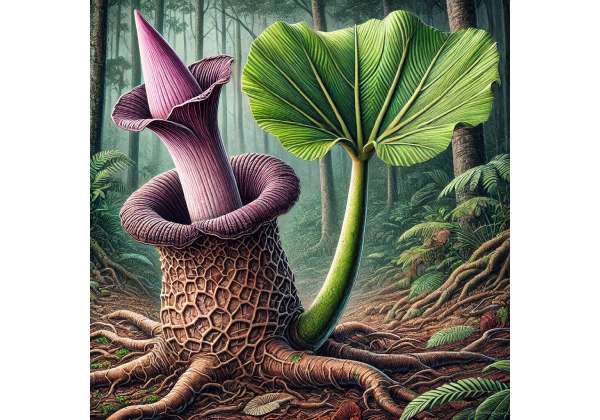Ensete: Benefits, Properties, and Uses
Ensete, often referred to as the "false banana," is a fascinating and versatile plant native to East Africa, particularly Ethiopia. Although it resembles the banana plant, Ensete is distinct in its appearance, uses, and cultural significance. With a robust, fibrous pseudostem and a large, starchy corm, Ensete is a staple food crop for millions and has been an integral...
English Yew: Health Benefits, Applications, and Side Effects
English Yew (Taxus baccata) is a majestic evergreen tree native to Europe that has fascinated botanists, herbalists, and landscape architects for centuries. Known for its dark, richly textured foliage, its distinctive red arils, and its slow, graceful growth, English Yew has long been a symbol of longevity, resilience, and mystery. Traditionally, various parts of the yew—especially its needles and...
English Walnut: Detailed Historical Usage, Natural Applications, and Health Benefits
English Walnut, scientifically known as Juglans regia, is one of the most popular and nutritionally dense tree nuts in the world. Renowned for its rich, buttery flavor and crunchy texture, English Walnut has been a culinary and medicinal staple for millennia. Beyond its role as a delicious ingredient in cooking, this nut is celebrated for its significant health benefits,...
English Stonecrop: Benefits, History, Properties, and Uses
English Stonecrop is a hardy, drought-tolerant succulent belonging to the Crassulaceae family, widely admired for its striking foliage and exceptional resilience. This versatile plant is cherished not only for its ornamental appeal in rock gardens and green roofs but also for its emerging role in natural medicine and wellness. Traditionally used in European folk remedies, English Stonecrop has gained...
English Lavender: Health Benefits, Medicinal Properties, and Uses
English Lavender, a classic member of the Lavandula angustifolia species, is renowned for its soothing fragrance, delicate purple blooms, and remarkable versatility. Cultivated for centuries across Europe, particularly in England and the Mediterranean region, this herb has long been celebrated for both its ornamental beauty and its broad spectrum of health benefits. Traditionally, English Lavender has been used in...
English Ivy: Complete Overview of Benefits, Health Properties, and Uses
English Ivy (Hedera helix) is one of the most recognizable and widely cultivated plants in the world. Known for its lush, evergreen foliage and climbing habit, English Ivy is a common sight on walls, fences, and in gardens throughout temperate regions. Beyond its ornamental appeal, English Ivy has a rich history of use in traditional herbal medicine and modern...
English Hawthorn: Therapeutic Benefits, Medicinal Properties, and Uses
English Hawthorn (Crataegus monogyna) is a well-known deciduous shrub native to Europe, valued for its ornamental beauty and its long-standing use in traditional medicine. With its small, white-pink flowers, bright red berries, and finely serrated leaves, English Hawthorn has been a familiar sight in hedgerows and gardens for centuries. Renowned for its cardioprotective, anti-inflammatory, and antioxidant properties, this herb...
English Daisy: Health Benefits, Properties, and Medicinal Uses
English Daisy, scientifically known as Bellis perennis, is a charming, low-growing perennial herbaceous plant that has captured the hearts of gardeners and herbalists alike. Widely recognized by its classic white petals and sunny yellow centers, English Daisy is more than just an ornamental delight—it also offers a wealth of health benefits and a rich cultural history. Traditionally used in...
Engelmann Daisy: Benefits, Health Properties, and Uses
Engelmann Daisy is a captivating herbaceous flowering plant prized for its delicate beauty and remarkable health properties. Known for its bright, cheerful blossoms and subtle, aromatic foliage, Engelmann Daisy has been used in traditional medicine and ornamental horticulture for centuries. This herb is celebrated not only for its aesthetic appeal in gardens but also for its adaptogenic, antioxidant, and...
Endive: Comprehensive Overview of Benefits, Uses, and Properties
Endive (Cichorium endivia) is a crisp, bitter leafy vegetable that has been enjoyed both for its unique flavor and its impressive nutritional profile. Widely used in salads, side dishes, and gourmet recipes, endive is also valued in traditional herbal medicine for its digestive, detoxifying, and antioxidant properties. With a history that dates back thousands of years, this versatile herb...
Enchanter’s Nightshade: Detailed History, Natural Uses, and Health Benefits
Enchanter’s Nightshade is an enigmatic herb renowned for its mystical allure and remarkable healing properties. Celebrated in traditional herbal medicine across Europe and Asia, this herb has been used for centuries to promote physical and spiritual well-being. With its deep, iridescent purple berries, silvery-green leaves, and a subtle, enchanting aroma, Enchanter’s Nightshade captivates both the eye and the senses....
Emu Bush: Essential Benefits, Applications, and Research Studies
Emu Bush is a striking native shrub endemic to Australia, celebrated for its ornamental beauty and versatile applications in traditional medicine. Often found in the arid and semi-arid regions of the Australian outback, Emu Bush has been used by Indigenous communities for centuries to address various health concerns and to promote general well-being. Today, its popularity extends beyond the...
Emblic: Guide to Health Benefits, Properties, and Uses
Emblic, scientifically known as Emblica officinalis and commonly called Indian gooseberry or amla, is one of the most revered herbs in traditional Ayurvedic medicine. Known for its potent antioxidant properties and high vitamin C content, Emblic has been used for centuries to enhance vitality, support the immune system, and promote overall wellness. This versatile herb is celebrated not only...
Emanating: Benefits, Uses, and Research
Emanating is a unique herb renowned for its remarkable ability to “emanate” healing energy and vital life force. With a storied past in traditional herbal medicine across various cultures in Asia and the Mediterranean, Emanating has been used for centuries to promote physical and mental well-being. Valued for its aromatic foliage, potent bioactive compounds, and adaptogenic properties, this herb...
Elsholtzia: Health Benefits, Properties, and Legacy
Elsholtzia is a versatile herb belonging to the Lamiaceae family, renowned for its aromatic qualities and extensive use in traditional medicine across East Asia. Often known by its local names such as "Xiang Ru" in Chinese, Elsholtzia has been used for centuries to treat a range of ailments including fever, inflammation, and digestive disorders. Its fragrant leaves, essential oils,...
Elodea: Therapeutic Benefits, Safety, and Environmental Applications
Elodea canadensis, commonly known as Canadian waterweed or pondweed, is a submerged aquatic plant native to North America. Revered for its significant role in freshwater ecosystems, Elodea has long been a subject of both ecological study and practical applications in water gardening and environmental management. With its slender, branching stems and delicate, feathery leaves, Elodea not only contributes to...
Eleuthero: Health Benefits, Traditional Uses, and Scientific Research
Eleuthero, commonly known as Siberian ginseng, is a revered herb that has been used for centuries in traditional medicine across Asia and Eastern Europe. Belonging to the Araliaceae family, Eleuthero is not a true ginseng but shares many of the adaptogenic qualities that make ginseng so popular. This herb is prized for its ability to boost energy, support the...
Eleusine: Benefits, History, Properties, and Uses
Eleusine is a genus of grasses in the Poaceae family that plays an important role in agriculture and traditional medicine. Best known for its most cultivated species, Eleusine coracana (commonly known as finger millet), this herb has been a staple crop and a vital source of nutrition for millions across Africa, Asia, and parts of South America. With a...
Elettaria: Health Benefits, Properties, and Culinary Applications
Elettaria, most famously represented by Elettaria cardamomum (commonly known as cardamom), is a highly prized spice and medicinal herb native to the lush tropical forests of India and Sri Lanka. Valued for its aromatic seeds and essential oil, Elettaria has played a vital role in traditional Ayurvedic and Unani medicine for centuries. Beyond its culinary applications as the “queen...
Elephant Ear: A Complete Guide to Benefits, Properties, and History
Elephant Ear is a striking tropical plant renowned for its enormous, heart-shaped leaves and its versatility in both ornamental horticulture and traditional medicine. Belonging to the Araceae family, Elephant Ear encompasses several genera—including Colocasia, Alocasia, and Xanthosoma—that are celebrated for their lush foliage and robust growth. These plants thrive in warm, humid climates and are a common sight in...
Elephantopus: Health Benefits, Properties, and Uses
Elephantopus is a medicinal herb that has been valued in traditional healing systems for centuries. Belonging to the Asteraceae family, this resilient plant is commonly known as Elephant's Foot due to its robust, fibrous base. Native to tropical and subtropical regions in Asia, Africa, and the Americas, Elephantopus has been widely used to treat a variety of ailments including...
Elephant Garlic: Health Benefits, History, Properties, and Uses
Elephant Garlic, scientifically known as Allium ampeloprasum var. ampeloprasum, is an impressive member of the Allium family, prized for its enormous bulbs and milder, sweeter flavor compared to conventional garlic. Although it resembles garlic in appearance, elephant garlic is botanically closer to leeks. Cultivated in temperate regions around the world, this versatile herb has a rich history in traditional...
Elephant Foot Yam: Therapeutic Benefits, Properties, and Natural Applications
Elephant Foot Yam, scientifically known as Amorphophallus paeoniifolius, is a remarkable tuberous plant celebrated for its edible, starchy corms and a long history of use in traditional medicine and cuisine. Widely grown in tropical and subtropical regions of Asia, Africa, and the Americas, this herb has been an essential part of cultural traditions and dietary practices for centuries. Known...
Elecampane: Comprehensive Overview of Benefits, Uses, and Recent Research
Elecampane, scientifically known as Inula helenium, is a robust perennial herb native to Europe and parts of Asia. Known for its tall, erect stature and large, fuzzy leaves, Elecampane has been used for centuries in traditional herbal medicine to treat respiratory and digestive ailments. Its distinctive, aromatic roots and bitter taste have earned it a reputation as a natural...
Elderflower: Health Benefits, History, Properties, and Medicinal Uses
Elderflower, derived from the Sambucus tree, is a cherished herb known for its delicate, fragrant white blossoms and rich history in traditional herbal medicine. Widely found across Europe and North America, elderflower has been used for centuries as a natural remedy for colds, flu, and various inflammatory conditions. In addition to its medicinal properties, the flower is celebrated for...
Elderberry: Complete Guide to Health Benefits, Medicinal Properties, and Uses
Elderberry, derived from the Sambucus genus, is a time-honored herb celebrated for its deep, rich berries and impressive health benefits. Known for its vibrant purple-black fruit, elderberry grows wild across temperate regions of the Northern Hemisphere and has been a staple in traditional medicine for centuries. Revered for its potential to support immune health, alleviate colds and flu, and...
Edelweiss: Health Benefits, History, Properties, and Modern Uses
Edelweiss is a legendary alpine flower, celebrated for its rare beauty, resilience, and deep cultural significance. Growing high in the rugged, snow-covered mountains of Europe, this iconic plant has become a symbol of purity, endurance, and the rugged charm of the alpine wilderness. Beyond its striking appearance—with its silvery-white, woolly petals contrasting against a backdrop of harsh mountain terrain—edelweiss...
Eclipta: Guide to Health Benefits, Medicinal Properties, and Uses
Eclipta is a versatile herb steeped in ancient tradition and modern interest. Commonly known as False Daisy or Bhringraj in Ayurvedic medicine, this herb has been used for centuries across Asia and other parts of the world. Revered for its potential to promote hair growth, support liver health, and serve as a natural remedy for various ailments, Eclipta continues...
Ecklonia: Therapeutic Benefits, Properties, and Natural Applications
Ecklonia is a remarkable genus of brown algae commonly found in the coastal waters of East Asia. Valued for its potent bioactive compounds and unique ecological role, Ecklonia has garnered significant attention in both traditional medicine and modern nutraceutical and cosmetic industries. Species such as Ecklonia cava are especially popular, owing to their rich content of antioxidants, anti-inflammatory agents,...
Echium: Complete Overview of Uses, History, and Health Benefits
Echium is a fascinating genus of flowering plants belonging to the Boraginaceae family. Known for its striking blue, purple, or white flowers and its robust, often hairy foliage, Echium has captured the attention of gardeners, herbalists, and naturalists alike. With species such as Echium vulgare (commonly known as viper's bugloss) and Echium candicans (often referred to as the Pride...








































